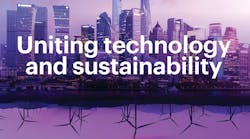By now most businesses have voiced their intentions to set specific environmental, social and governance (ESG) goals but not all companies have other business strategies aligned to meet these goals.
In a new study from Accenture, Uniting Technology and Sustainability: How to Get Full Value From Your Sustainable Technology Strategy, it turns out that only 7% of respondents have fully integrated their business, technology and sustainability strategies despite having ranked technology as important or very important for achieving their sustainability goals.
While companies see clear value in having an integrated strategy, they cite a lack of solutions and standards (40%), complexity (33%) and lack of awareness of unintended consequences of technology (20%) as barriers to reaching their goals. This gap between intent and action leads companies to make trade-offs between business and sustainability goals — trade-offs that can be reduced or eliminated with a holistic, sustainable technology strategy.
Looking at how the leadership can play a role, it turns out that only 49% of Chief Information Officers (CIOs) are part of the leadership team setting sustainability goals, and just 45% are assessed on achieving these goals.
“Every business must be a sustainable business and technology is a critical and fundamental enabler –from improving transparency and traceability in global supply chains, to helping measure and reduce carbon emissions,” said Sanjay Podder, Technology Sustainability Innovation lead at Accenture, in a statement. “It is no longer simply optional to put sustainability at the core of how organizations operate. A sustainable technology strategy — one that embeds sustainability in technology, drives sustainability by technology, and scales sustainability by engaging the ecosystem — will help companies deliver 360° value and contribute to the achievement of their broader sustainability goals.”
Accenture notes that an effective sustainable technology strategy helps drive business growth and ESG performance by delivering on three key imperatives:
- Sustainability by technology: Using the power of technology to enable and accelerate sustainability efforts across the organization. Ninety-two percent of companies surveyed aim to achieve net-zero targets by 2030, which will require deployment of advanced technologies to measure, reduce and remove an organization’s carbon footprint. Technology is also key for moving toward responsible value chains; promoting sustainable choices for customers; and building a sustainable organization. Of the companies surveyed that successfully reduced emissions in production and operations, 70% used artificial intelligence (AI) to do it.
- Sustainability in technology: Protecting people and the planet by making technology itself progressively more sustainable. As more people go online and the use of technology increases, so do the carbon emissions from IT. Embracing green software that is both carbon-efficient and carbon aware; building trustworthy systems that incorporate privacy, fairness, transparency, robustness and accessibility; and instituting the right governance mechanisms must be prioritized. Only two of the 560 companies surveyed said they consider energy efficiency at all stages of the software development lifecycle, indicating considerable room for improvement. The report identifies a robust green software development framework that prioritizes material emissions areas including the software development life cycle, as well as green digital experience, cloud, edge, data centers, AI, distributed ledger technology and infrastructure.
- Sustainability at scale: Pursuing breakthrough innovation with ecosystem partners to develop radically different and more sustainable ways of doing business in the future. No organization can address global sustainability challenges at scale on its own. Companies must work beyond the boundaries of their own organizations to meet the United Nations Sustainable Development Goals (SDGs). Forty-three percent of companies surveyed are now joining industry collaborations, alliances and advocacy groups focused on eco-friendly technology.
Podder added, “Creating and implementing a comprehensive sustainable technology strategy — one that uses technology to drive sustainability at scale while also making technology itself more sustainable — is now the core mission of the purpose-driven CIO. The responsibility is huge, but the opportunity to drive new sources of value and lead the way to a more sustainable future is even bigger.”
